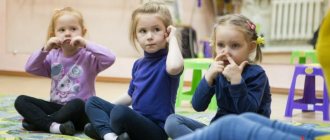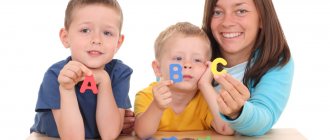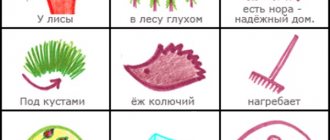About the benefits of finger exercises
Finger games are not only fun, but also extremely useful for kids. They contribute to:
- Development of fine motor skills, and therefore speech;
- Development of coordination of movements;
- Preparing your hand for writing;
- Expansion of vocabulary;
- Development of attention, memory, imagination;
- Relieving emotional and mental stress;
- Establishing warm physical contact between a child and an adult.
Finger games have been known to man for many years. Long before scientific confirmation that a baby’s speech depends on the development of fine motor skills, our ancestors noticed that stroking and massaging fingers brings great benefits to the child.
The benefits of gymnastics for fingers from 6 months
Finger gymnastics is a set of exercises that is accompanied by funny stories and rhymes. Gymnastics for the youngest children (up to one year) is supplemented by massage actions from an adult.
Finger exercises are very useful because they:
- Helps to shift attention. If the baby is capricious, then you can captivate him by reciting a few poems, accompanying your speech with a massage of his fingers and toes.
- Improves coordination and fine motor skills.
- Eliminate emotional stress.
- Develop memory.
- Promote coordination of movements and speech in the future.
- They give an impressive effect of active physical and intellectual development.
- Improve communication skills. From birth, a child requires communication.
Educational games contribute to the rapid development of speech, so the baby begins to express his desires and feelings verbally early. - Helps develop imagination and creative initiative.
- They are a means of initial aesthetic education.
Another advantage of finger games is the impact on special points located on the hands, palms and feet. Stimulation of such acupuncture zones improves the functioning of the internal organs associated with them, namely:
- thumb massage has a positive effect on the brain and central nervous system;
- massage of the index finger improves the activity of the stomach;
- stroking the middle finger helps improve bowel function;
- stimulation of nerve endings on the ring finger has a beneficial effect on the kidneys and liver;
- Pressing the points located on the little finger improves the activity of the cardiovascular system.
See also:
A child does not speak at 3 years old - what to do and where to go?
How to play with a child?
Babies under one year old cannot yet repeat the movements of an adult, so at this age massage of the hands and each finger individually is most relevant. It is advisable to accompany the movements with short poems and nursery rhymes, for example: “This finger is small, this finger is weak, this finger is long, this finger is strong, this finger is fat, and together they are a fist.” Finger games with children of the second year of life are also passive. Little by little, children learn to repeat simple movements such as clenching their fingers into a fist, clapping, etc. Two-year-olds can already perform simple exercises on their own. Preschool children can be offered games with a variety of movements that develop coordination and dexterity. The most popular among parents at the moment are finger games to the music of E. Zheleznova, for example: “Worms”, “Spider”, “Clock”, “Glove” and many others. Their text, movements and music can be easily found on the Internet.
Article:
The relationship between the development of fine motor skills of the hands and speech has been noticed by child psychologists for a long time. One of the effective ways to develop fine motor skills is exercises for the development of fingers or finger gymnastics. The child, together with the adult, recites short poems, accompanying each phrase with finger movements. Such exercises enhance the coordinated activity of speech zones, promote the development of imagination and memory, and the fingers and hands acquire flexibility and pliability. And the most important thing is that the child perceives finger gymnastics as a game and completes all tasks with pleasure.
Finger gymnastics. Exercise “We chop cabbage”
We chop and chop cabbage! (2 times) (the child imitates the chopping movements of an ax, moving his straight palms up and down) We cut the cabbage, cut it! (2 times) (move the edge of your palm back and forth) We salt the cabbage, salt it! (2 times) (gather our fingers into a pinch and pretend to salt the cabbage) We squeeze the cabbage, squeeze it! (2 times) (vigorously clench and unclench our fists) We three, three carrots! (2 times) (clench the right hand into a fist and move it up and down along the straight palm of the left hand, pretending to be a grater)
Finger gymnastics. Exercise “Bake pies”
We knead the dough, knead it, knead it! (the child alternately “presses” the imaginary dough with his fists) Press the dough, press it, press it! (the baby sharply clenches his fingers into fists and unclenches them, first simultaneously, then alternately) We will bake pies! (we “make” pies with our hands, as if transferring from one palm to another)
Finger gymnastics. Exercise "Lock"
There is a lock hanging on the door (we join our hands in a lock, intertwining our fingers) Who could open it? Twisted, (turn the lock without releasing the fingers) Pulled, (move our palms apart in different directions, fingers still clasped) Knocked, (palms clap each other, fingers remain in the lock) And opened! (unlock fingers)
Finger gymnastics. Exercise “bunny with drum”
The index and middle fingers are raised up (these are the ears of a hare), the little finger and ring fingers are pressed to the palm. The thumb taps the ring and little fingers. The bunny is drumming on a drum. There-there-there. There-there-there.
Finger gymnastics. Exercise “Feet walked along the road”
The big legs walked along the road, stomping, stomping, stomping (for each “stomp,” we slowly place our right and left hands on the table surface alternately, depicting the movements of the legs) Small legs ran along the path, stomping, stomping, stomping, stomping, stomping (the line reads at a faster pace, the index and middle fingers of the hand move along the surface of the table, imitating running)
Finger gymnastics. Exercise “Finger Boy”
The fingers of the hand are clenched into a fist. For each line of the rhyme, the child extends (using the other hand) one finger. Finger-boy, where have you been? (raise our thumb and address him) I went into the forest with this brother. (extend the index finger) I cooked cabbage soup with this brother. (extend the middle finger) I ate porridge with this brother. (extend the ring finger) I sang songs with this brother. (extend the little finger) Then you can change hands.
General recommendations for parents:
- Create a positive attitude before the game;
- The game should be fun for both you and your baby;
- Give your child simple age-appropriate instructions (explain that he should repeat the movements after you or play with his fingers independently, accompanying the actions with speech);
- Do not play for more than 5 minutes at a time;
- Don’t try to learn as many finger games as possible with your baby (“less is more”);
- It is advisable to learn the movements first with your right hand and then with your left. When the child is sufficiently prepared, you can perform movements with both hands at the same time.
Do not force your child to do finger gymnastics if he is not in the mood. It's better to take a break and return to games when the baby wants it.
Finger gymnastics for children 3-4 years old
Bunny
The bunny was jumping through the forest, (his fingers “jumping” on the table) The bunny was looking for food for himself. (we move the fingers of both hands one by one on the table) Suddenly, on the top of the bunny’s head, the ears rose up like arrows. (we depict ears with our hands) A quiet rustling is heard: Someone is sneaking through the forest. (fingers slowly walk along the table) The hare confuses his tracks, runs away from trouble. (fingers quickly and quickly run in circles on the table)
Orange
We shared an orange! (hands clasped together, we shake) There are many of us, (we spread our fingers) And he is alone. (show only one finger) This slice is for a hedgehog, (fingers folded into a fist, bend one finger at a time) This slice is for a swift, (bend the next finger) This is a slice for ducklings, (bend the next finger) This is a slice for kittens, (bend the next finger finger) This slice is for the beaver, (bend the next finger) And the peel is for the wolf! (palms down, fingers spread) He's angry with us, it's a disaster! (wag a finger) Run away in all directions! (imitate running your fingers on the table)
Snail
The snail pokes with its horns - (the thumb of the right hand is held by the middle and ring fingers; the index and little fingers are straight) The gate in the garden is locked. (pokes “horns” into the palm of his left hand) Open the gate quickly, (left hand “opens” the gate), Let the snail home (right hand “crawls”).
Advertising
Why are finger games so important?
The fact is that in the palm of your hand, especially on the fingers, there are many nerve centers that are associated with speech and intellectual development.
Therefore, the development of the hand, starting with simple stroking, bending the fingers and ending with the actual games - performing coordinated actions with the fingers to a rhyming poem - is so important for the timely mastery of the necessary skills. In addition, as you will soon see, this is an easy way to have fun and interesting time with your child at any time: in between household chores, on the way on public transport, or while putting your child to bed. On the other hand, finger play is a good way to distract a child from his whims and quickly switch his attention.
The benefits of finger games for babies
Connections between areas of a newborn's brain are not yet fully formed. Creative abilities depend on the correct functioning of the right hemisphere, and thinking on the left hemisphere. Both parts must work in harmony and be equally developed, only then will the baby speak in time and understand someone else’s speech. Sometimes parents notice that the baby hears well, understands questions and requests addressed to him, but says almost nothing. If everything is normal with the speech apparatus, most likely there is a problem with the development of the corresponding part of the brain. Speech is formed in the right hemisphere, which is connected to the left hand. If parents are too carried away with training the working hand, and forget about the second one, they urgently need to correct this mistake.
Weak muscles in babies can be trained with massage and exercises, but how to enhance the development of the contents of the cranium? There is a very simple way - finger games. During these activities, you develop not only the baby’s hands; when the fingers move, very important processes occur in the body:
- all muscles relax;
- attention is activated;
- thinking develops;
- connections necessary for complex activities are formed;
- imagination and creativity develops.
Finger gymnastics exercises are also necessary for forming contact with parents; they prepare the child for joint activities. When you simply tell your child a story or sing a song, he is not a participant, but a spectator. But during hand gymnastics, there is constant communication and close contact with the mother. The child needs to listen carefully and watch you in order to complete his task correctly. He will need these abilities to play with other children, to play sports, and to perform various jobs.
Advice
Children are very impatient; 5 minutes of waiting for a bus or a queue at a children's clinic turns into torture for them. If the wait drags on for half an hour, whims and hysterics begin. As soon as you notice that your baby is bored, keep his fingers busy and the time will fly by. In the same way, you can distract him if the child is interested in a dangerous object or he wants to run into a street filled with cars.









